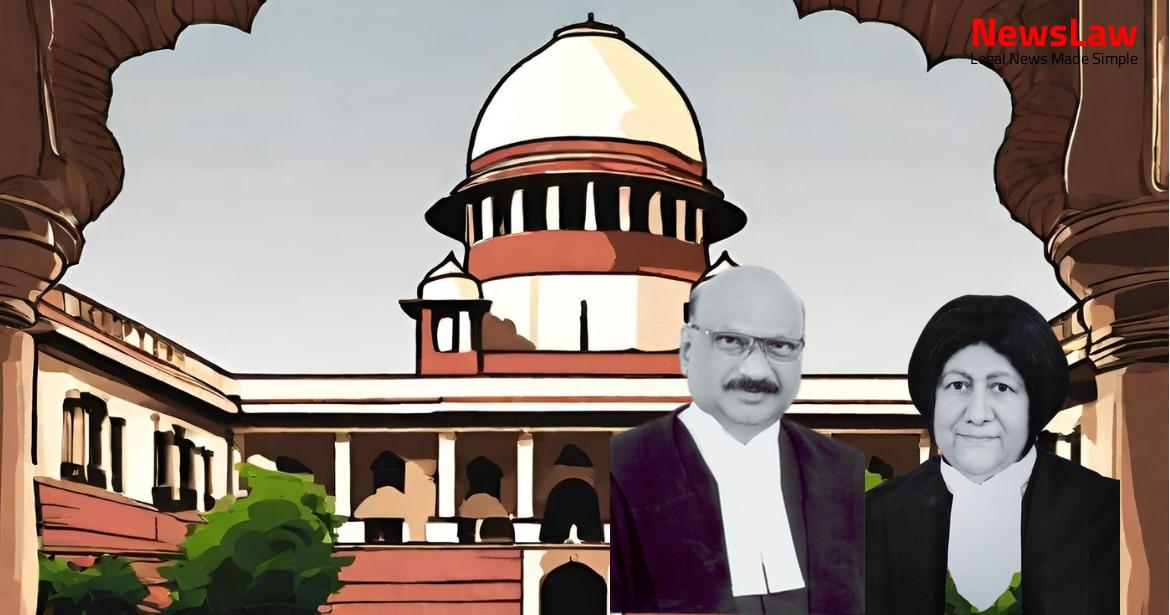In a recent legal case, the court’s analysis of sentencing has come under scrutiny for its oversight. The judgment dives deep into the principles of just punishment, considering factors like the impact on society, victimology, and deterrence. Let’s unravel the complexities of legal sentencing and its crucial role in upholding the justice system’s integrity.
Facts
- The High Court convicted respondent No.1 under Section 304 Part II of the IPC based on the testimony of the doctors, PW-1 and PW-2.
- The original FIR was registered based on information provided by one Shri Jaswinder Singh (Informant) about an incident at Battian Wala Chowk.
- Various medical reports and opinions were sought regarding the cause of death of the deceased Gurnam Singh, with conflicting views on whether it was due to subdural haemorrhage or sudden cardiac arrest.
- Two accused were involved, with respondent No.1 inflicting fist blows on the deceased after a dispute over right of way, leading to the death of Gurnam Singh.
- The trial court initially acquitted both accused, but the High Court convicted respondent No.1 under Section 304 Part II of the IPC and respondent No.2 under various sections of the IPC.
- The medical examination and post-mortem reports played a crucial role in determining the cause of death, with a Medical Board being constituted to investigate further.
- The Sessions Court invoked Section 319 of the Cr.P.C. to summon respondent No.1 for trial based on the statement of the Informant.
- Respondent No.1 was held not guilty of causing the death of Gurnam Singh, but guilty of voluntarily causing hurt under Section 323 of the IPC.
- The post-mortem report showed only two external injuries – abrasions on the temporal region and left knee of the deceased.
- The Court examined the proposition that cases convicting for grievous hurt in a homicide may fall within Section 300 (thirdly) of the IPC.
- Lapses in investigation were acknowledged, but convictions cannot be solely based on doubts.
- The testimony of witnesses was considered trustworthy by the Court.
- The judgment analyzed the intention to inflict injury to cause death in the ordinary course of nature.
- There was uncertainty regarding the cause of death, no weapon was used, and the incident resulted from an instant brawl.
- A fine of Rs. 1,000 was imposed as sentence due to the incident being 30 years old, lack of enmity, and absence of weapon usage.
- The review application was limited to the question of enlarging the sentence for respondent No.1.
- The case against respondent No.2 was not proven, and presence with respondent No.1 did not imply common intention or guilt under Section 323 of the IPC.
Also Read: Supreme Court Judgment on Single Till Mechanism for HRAB Calculation: A Comprehensive Analysis
Issue
- The issue to be analysed is whether a grave error was committed on the issue of sentence by not imposing any term of imprisonment.
- The question revolves around the adequacy of the sentence imposed in the factual scenario presented.
- The judgment seeks to determine whether the decision not to punish with imprisonment at all was appropriate given the circumstances of the case.
Arguments
- Section 300 thirdly of the IPC would be unnecessary as the act falls under the first part of the section.
- Establishment of bodily injury, nature of injury, and its impact on vital organs is crucial.
- Intention to inflict bodily injury must be established, especially considering the effect on the elder victim.
- Sentence imposition should correlate to the severity of the offence and deterrence aspect.
- Spontaneous incidents without weapons should not result in minimal punishment.
- Leniency is not acceptable when hurt/injury leads to death, regardless of trial delay.
- Consideration of aggravating and mitigating factors is essential for sentencing decisions.
- Delay of 34 years should not be a grounds for acquitting the accused if not attributable to complainants or victims.
- Learned senior counsel for respondent No.1 emphasized that the incident in question is 34 years old and related to a dispute of right of way.
- It was argued that the case had already undergone several rounds of scrutiny at different stages, and re-assessing the merits of the case in terms of the charges against the respondent could undermine the basic foundations of the criminal justice system.
- The Court expressed disinclination to expand the notice beyond the aspect of sentencing.
- It was contended by the senior counsel for respondent No.1 that a review petition on the quantum of sentence was not maintainable, citing specific judgments like Parvinder Kansal v. State of NCT and Mallikarjun Kodagali v. State of Karnataka & Ors.
- The counsel argued that the victim’s right to appeal should be limited to specific scenarios, such as acquittal of the accused, conviction for a lesser offense, or imposition of inadequate compensation, with no provision for the victim to challenge the quantum of sentence as inadequate.
Also Read: Selection and Appointment of Judicial Officers in Himachal Pradesh
Analysis
- The importance of not showing undue sympathy in imposing inadequate sentences to maintain public confidence in the justice system.
- Courts have a duty to award proper sentences considering the nature of the offense to prevent private vengeance.
- Leniency should not be granted solely based on the court’s discretion.
- The severity of a sentence should not be disproportionate but should also not be manifestly inadequate to deter future offenses.
- Consideration of the nature of injuries and the impact of the offense on society is crucial in determining the appropriate sentence.
- The defendant’s physical fitness and awareness of the force behind their actions should be taken into account during sentencing.
- Judgments were referenced to refute the argument that victims should not have a say in sentence enhancement.
- Maintaining a reasonable proportion between the crime’s severity and the punishment is essential in sentencing.
- The principle of just punishment is fundamental in sentencing for criminal offenses.
- Factors such as lack of post-enmity, absence of weapons, and the circumstances of the altercation were weighed in determining the sentence.
- The rejection of expanding the scope of the review application and the need for sentences to align with the brutality of the crime.
- Deliberations on the adequacy of a fine as a sentence in the case of a fatal blow, and the necessity of consistency in sentencing based on the crime’s brutality.
- The conviction is under Section 323 of the IPC relating to causing hurt.
- Section 323 of the IPC states the punishment for voluntarily causing hurt.
- The punishment under Section 323 includes imprisonment of up to one year, a fine of up to Rs. 1,000, or both.
- The purpose of imposing adequate sentencing is to protect society and deter criminals.
- The sentencing philosophy aims to make the accused realize the impact of their crime on both their own life and the social fabric.
- Opinions from State of Karnataka v. Krishnappa and Alister Anthony Pareira v. State of Maharashtra emphasize the principles of deterrence and correction in sentencing.
- Recent judgments highlight the importance of victim’s rights in the criminal justice system.
- Victims have substantive, enforceable rights that should not be limited or overshadowed by the state’s role in proceedings.
- Courts should base sentencing decisions on proportionality and deterrence, considering the seriousness of the offence and its consequences.
- The victim’s perspective is crucial in criminal justice, and sentencing should aim to provide just punishment without disregarding the victim’s suffering.
- US Supreme Court cases like Payne v. Tennessee stress the importance of victim impact statements during sentencing in capital offenses.
- A disproportionately light punishment can lead to humiliation and frustration for the victim and erode faith in the criminal justice system.
- Focus on victimology in criminal jurisprudence reflects a balanced perception of trials from both criminal and victim viewpoints.
- Court intervened to ensure relevant people are charged
- Evidence leading process was crucial
- Doctors hesitancy impacted the court’s opinion
- Case found to be under Section 323 of the IPC beyond reasonable doubt
- Relevant sentencing facts were overlooked resulting in only a fine for respondent No.1
- No room for two possible views in this case
- Review exercise justified due to sentencing oversight
- Imposition of only a fine considered not sufficient in this instance
Decision
- The court imposed a sentence of imprisonment for a period of one year rigorous imprisonment on respondent No. 1.
- The review applications/petitions are allowed to the extent mentioned, and in addition to the fine imposed.
Case Title: JASWINDER SINGH (DEAD) THROUGH LEGAL REPRESENTATIVE Vs. NAVJOT SINGH SIDHU (2022 INSC 603)
Case Number: R.P.(Crl.) No.-000477 / 2018



